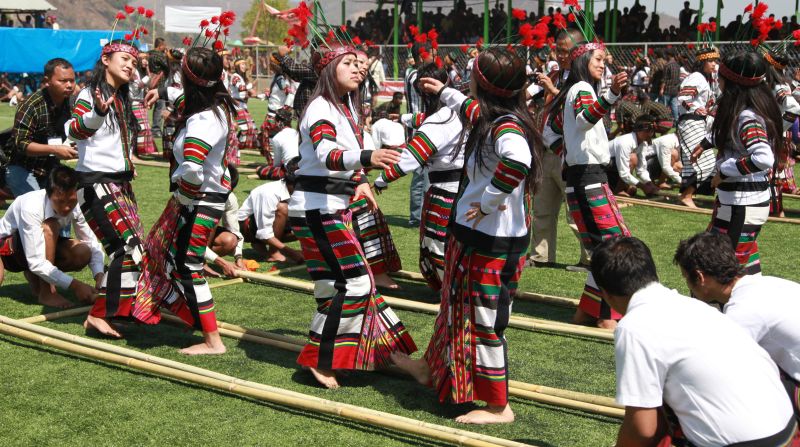The different tribes and their celebrations are a reflection of the Naga culture. An integral part of the Naga culture is the famous Cheraw dance. It is also known as the Bamboo dance in Nagaland.

This folk dance is known to people all over the world. Every year many tourists visit the state to enjoy a glimpse of the dance performance. The Bamboo dance is also performed in the neighboring states of Tripura, and Manipur other than Nagaland and Mizoram.
History of the Bamboo Dance
Cheraw dance is known as the Bamboo dance in Mizoram. The Bamboo dance got its name from the prop used during the dance, the bamboo sticks. According to tribal history, Bamboo dance might have originated in the first century AD.
The dance performance was for the peace of a mother’s soul who died during childbirth, leaving the child behind in this world. However, with time the meaning has changed. Now Cheraw dance is a source of entertainment for the people during the famous Hornbill Festival of Nagaland.
Cheraw Dance Performance
Cheraw dance performance is worth being a part of. It is the essence of all major festivals held in Nagaland. It is performed by both men and women of the tribe. The Cheraw dance is a group activity, where some people handle the bamboo sticks and the others dance in the mesh-like structure created with bamboo sticks. The dance requires a great deal of skill and practice and is, therefore, performed by professionals only.
Two bamboo sticks are placed vertically leaving some space in between. On top of these multiple sticks are placed horizontally. Three to four people sit on either side of this structure and slide the horizontal bamboos in a rhythm. This alignment of the bamboos creates small grids in the space between the vertical bamboos. This is where the dancers stand and move their feet to rhythmic music.
The dancers match their footsteps to the shifting bamboos. The steps are simple and calculated hops between the bamboo sticks, avoiding any contact with the sticks. The dancers move in and out from the grid formed by the horizontal bamboos, initially slow and gradually picking up pace.
The dancers recite “hih-hoh” along with the singers during the entire performance. The sliding bamboos also produce a sound that enhances the program.
Dance Costume
Cheraw dancers are required to put on the traditional attire of the Nagas. The women are seen wearing long-sleeved white blouses with a red and black checked pattern on the chest and the sleeves. On the bottom, they wrap a dark black or brown skirt with red and white horizontal stripes of various colors. The headgear worn is made of bamboo and adorned with bird feathers. Bead jewelry is work on the neck, ears, and hands.
The men wear the traditional dhoti similar to the skirt worn by the females. The top is usually bare or cloth is wrapped in a criss-cross fashion across the chest. The headgear is the same as the women’s, only bigger. They also adorn themselves with bead jewellery of various sizes and shapes.
Pingback: Dance of Nagaland - Auchitya
Pingback: All Folk Dances of India - Auchitya
Pingback: Naga Dance - War Dances Celebrated by Tribes of Nagaland - Auchitya
You have mixed up Cheraw dance of Mizo with others. The picture you have shown here is also purely mizos at AR Ground, Aizawl,Mizoram.